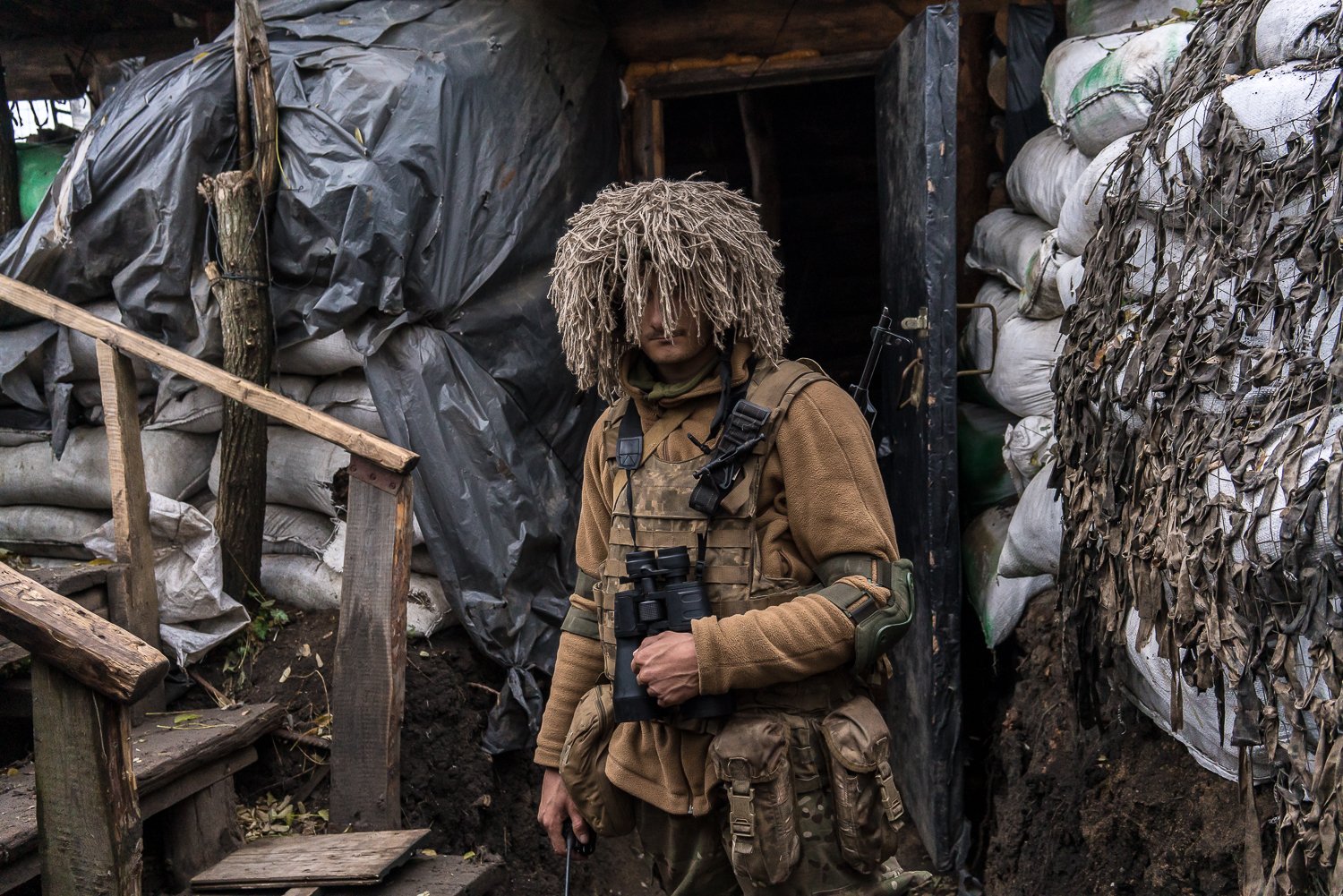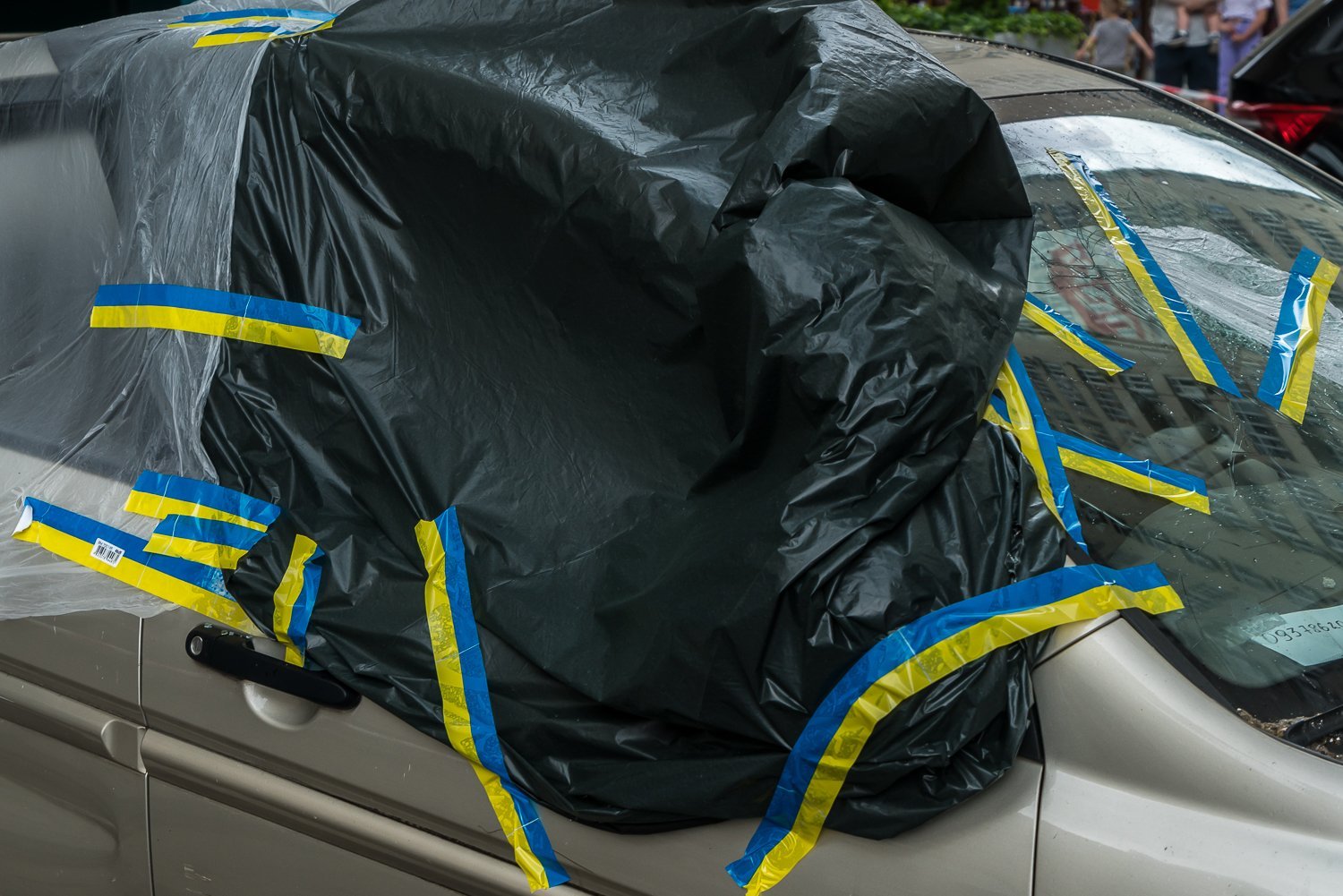Maidan: The Dignity of Revolution
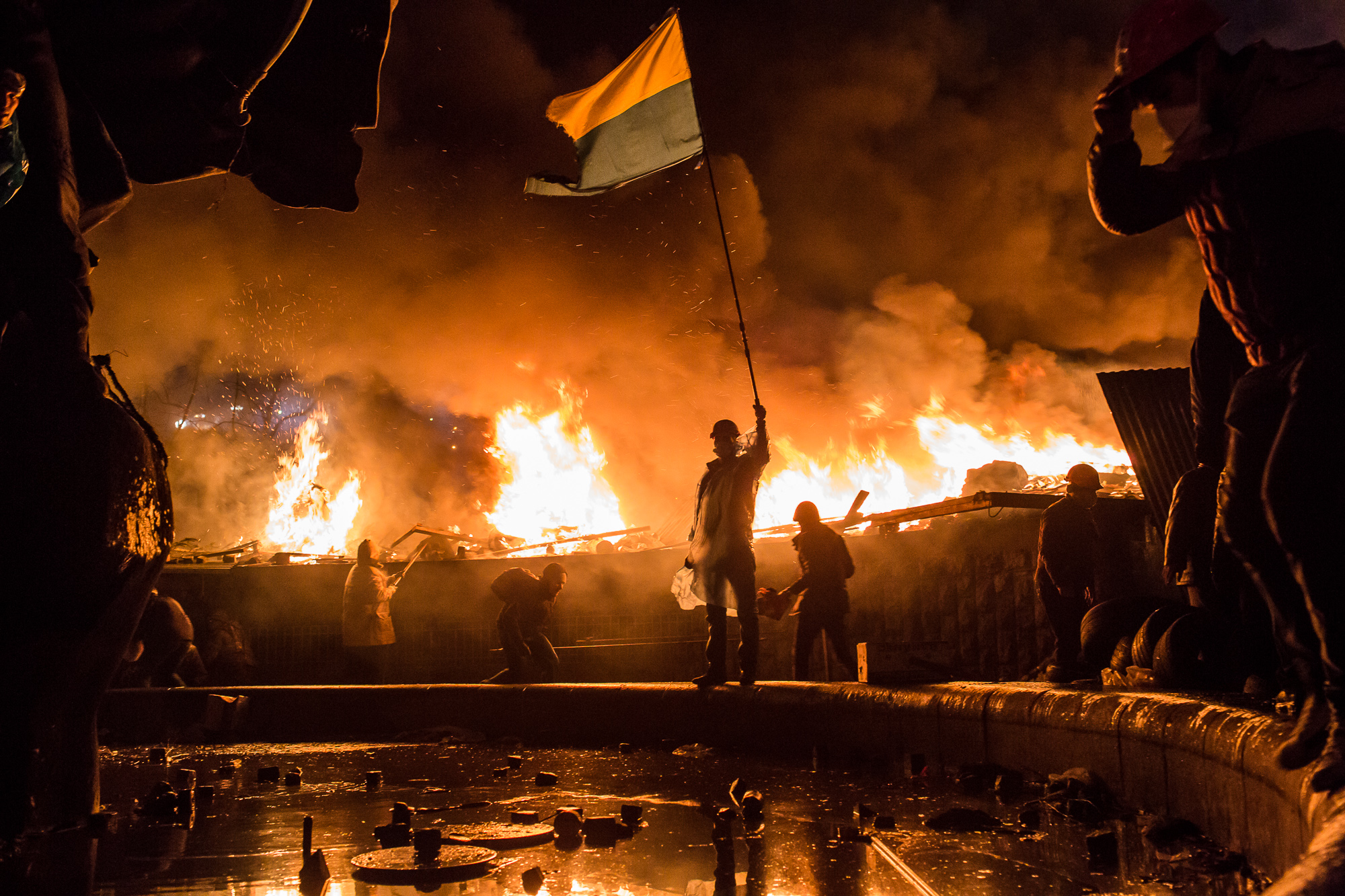
Anti-government protesters guard the perimeter of Independence Square, known as Maidan, on February 19, 2014 in Kiev, Ukraine. After several weeks of calm, violence has again flared between police and anti-government protesters, who are calling for the ouster of President Viktor Yanukovych over corruption and an abandoned trade agreement with the European Union.
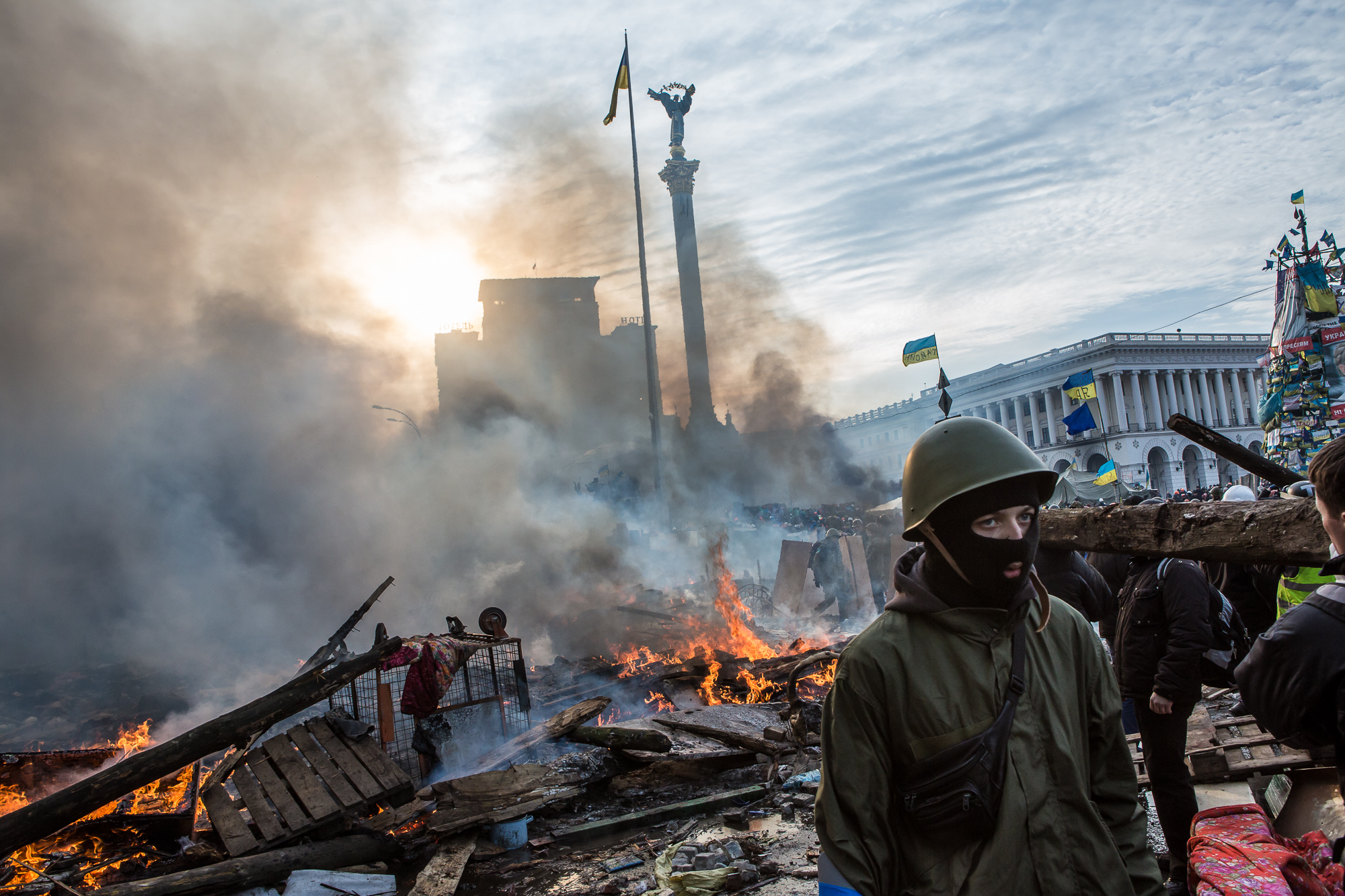
Anti-government protesters walk amid debris and flames near the perimeter of Independence Square, known as Maidan, on February 19, 2014 in Kiev, Ukraine. After several weeks of calm, violence has again flared between police and anti-government protesters, who are calling for the ouster of President Viktor Yanukovych over corruption and an abandoned trade agreement with the European Union.

Police block the road near the Ukrainian Cabinet of Ministers building on January 24, 2014 in Kiev, Ukraine. After two months of primarily peaceful anti-government protests in the city center, new laws meant to end the protest movement have sparked violent clashes in recent days.
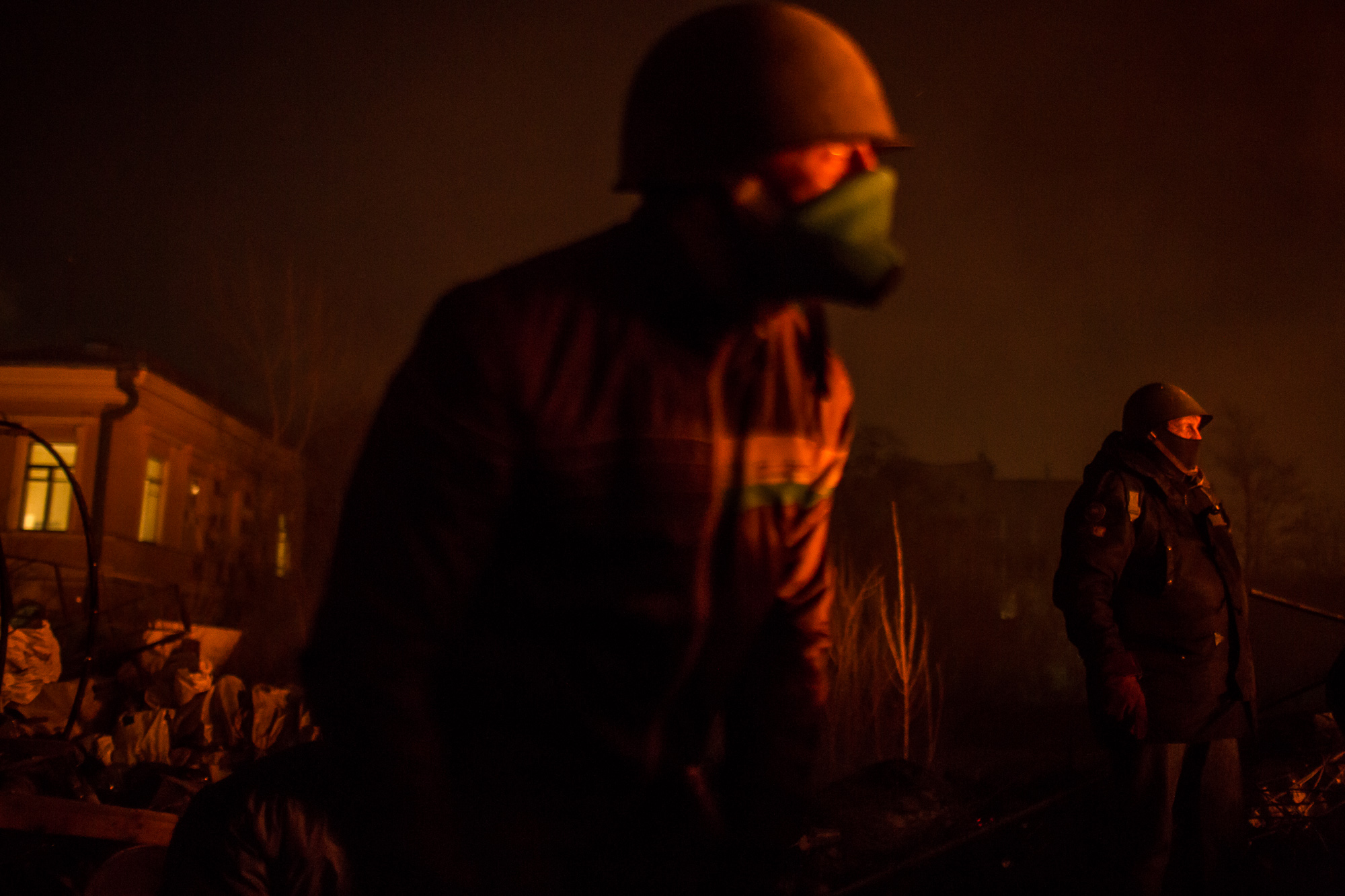
Anti-government protesters stand watch at front-line barricades on Instytutska Street, near Independence Square, on February 20, 2014 in Kiev, Ukraine. After several weeks of calm, violence has again flared between anti-government protesters and police, with dozens killed. (Photo by Brendan Hoffman/Getty Images)
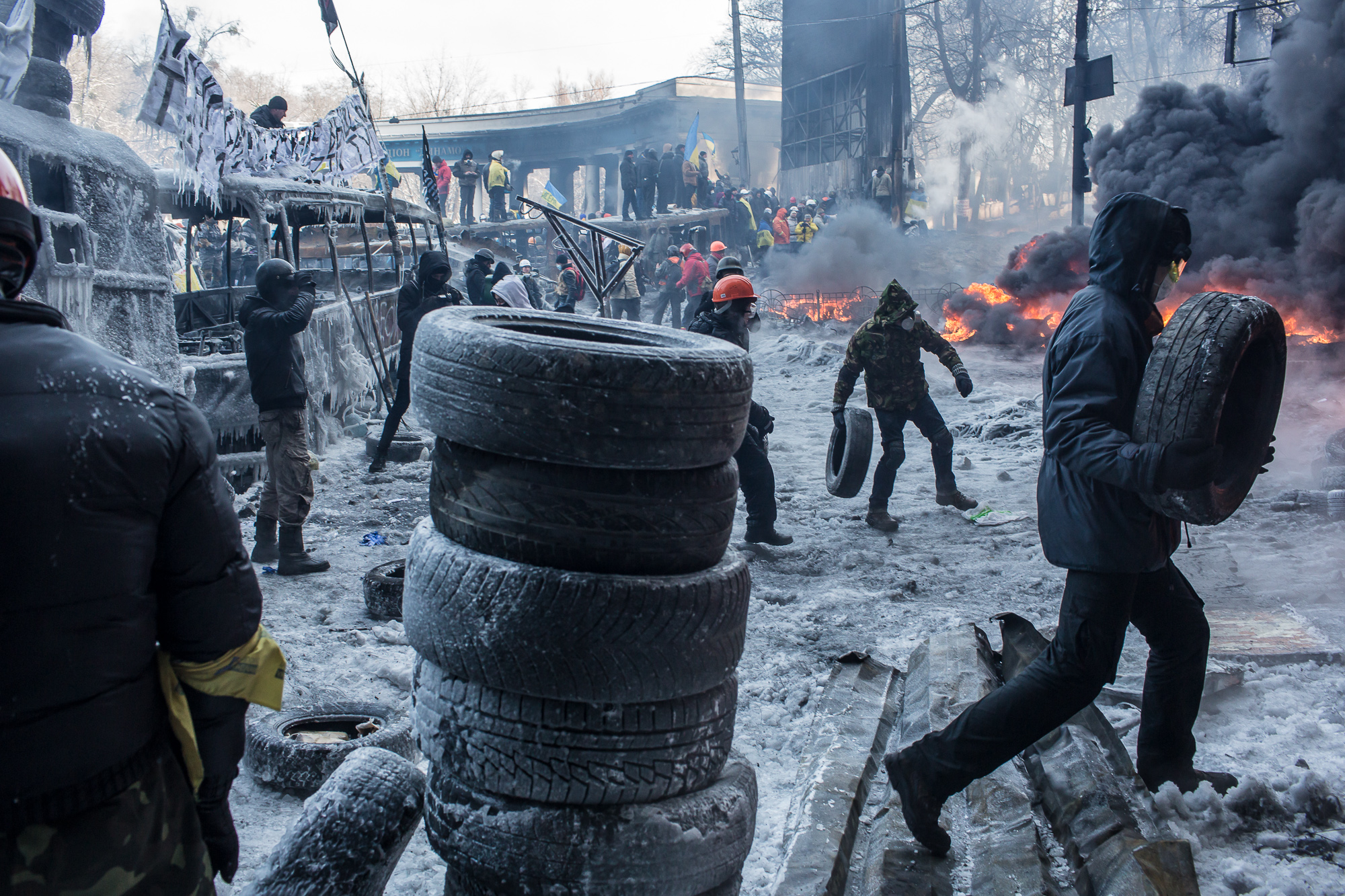
Anti-government protesters burn tires during clashes with police on Hrushevskoho Street near Dynamo stadium on January 25, 2014 in Kiev, Ukraine. After two months of primarily peaceful anti-government protests in the city center, new laws meant to end the protest movement have sparked violent clashes in recent days.
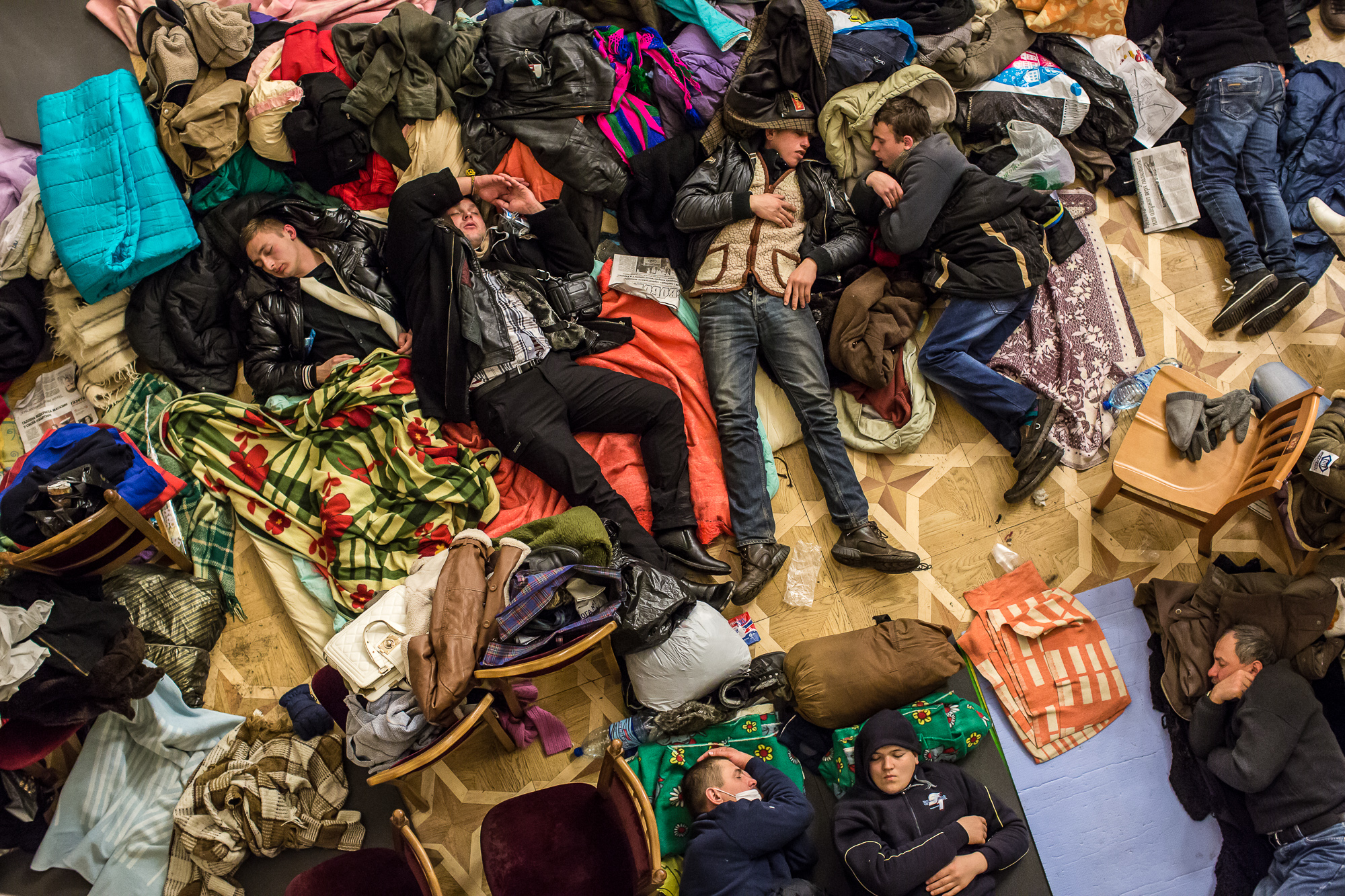
Anti-government protesters sleep on the floor of the occupied Kiev City Hall on December 7, 2013 in Kiev, Ukraine. Thousands of people have been protesting against the government since a decision by Ukrainian president Viktor Yanukovych to suspend a trade and partnership agreement with the European Union in favor of incentives from Russia.
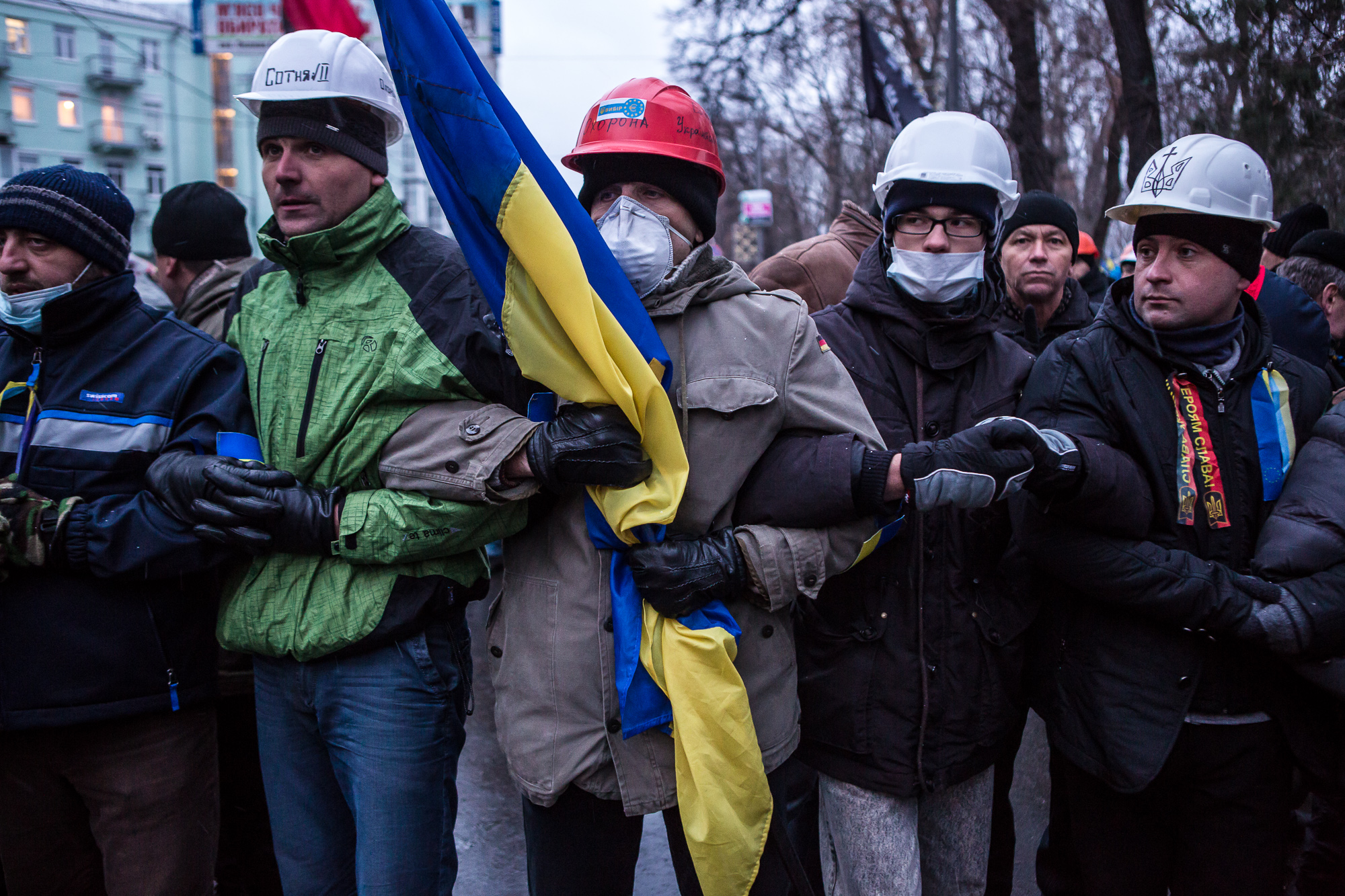
Anti-government protesters lock arms to block access to a street that leads to the Ukrainian parliament building, the site of a rally held by the ruling Party of Regions in support of the government and Ukrainian president Viktor Yanukovych, on December 8, 2013 in Kyiv, Ukraine. Thousands of people have been protesting against the government since a decision by President Yanukovych to suspend a trade and partnership agreement with the European Union in favor of incentives from Russia.

Anti-government protesters throw Molotov cocktails at police during clashes on Hrushevskoho Street near Dynamo stadium on January 25, 2014 in Kyiv, Ukraine. After two months of primarily peaceful anti-government protests in the city center, new laws meant to end the protest movement have sparked violent clashes in recent days.
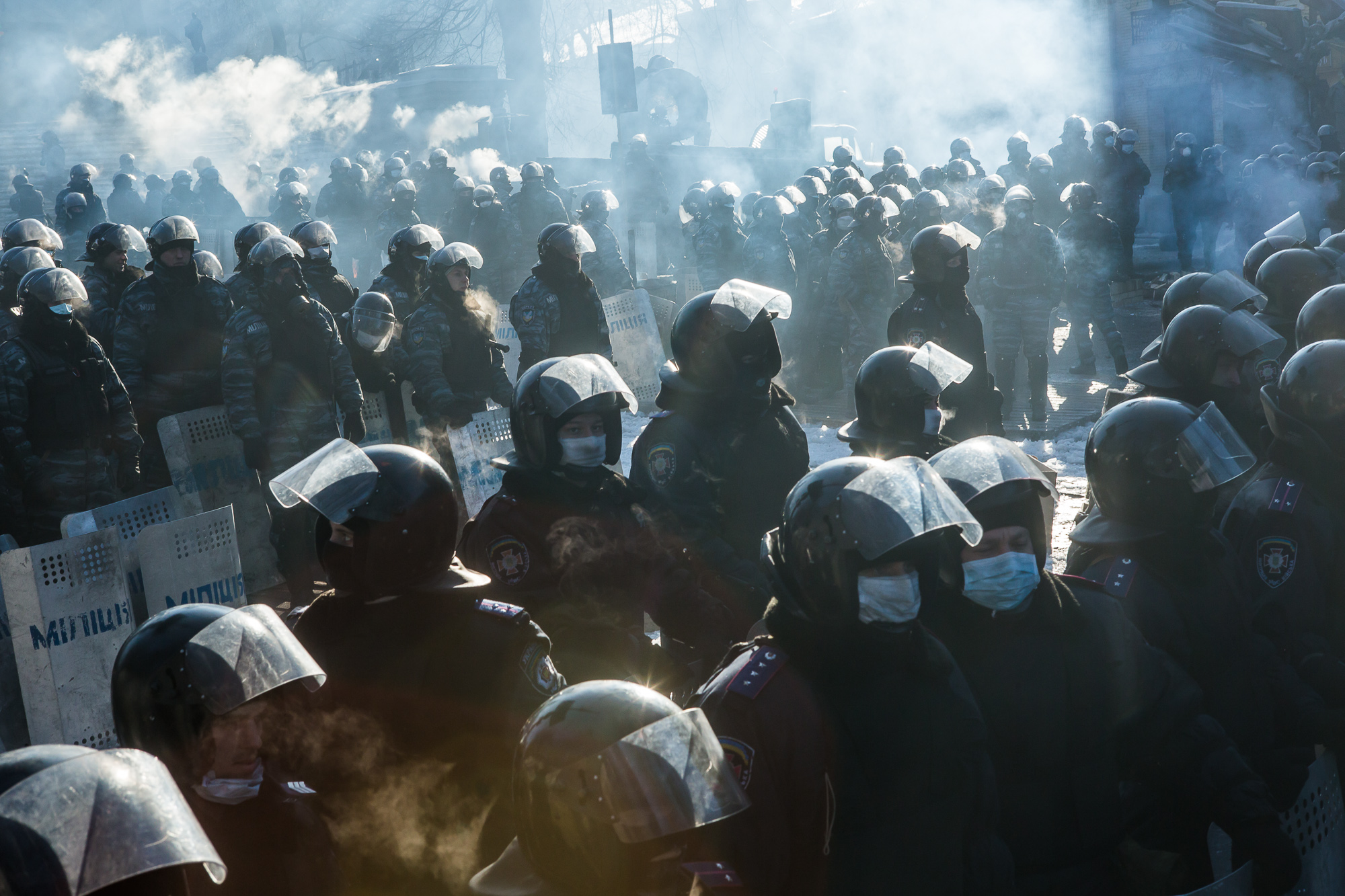
Police officers block the street near the Cabinet of Ministers building on January 24, 2014 in Kiev, Ukraine. After two months of primarily peaceful anti-government protests in the city center, new laws meant to end the protest movement have sparked violent clashes in recent days.
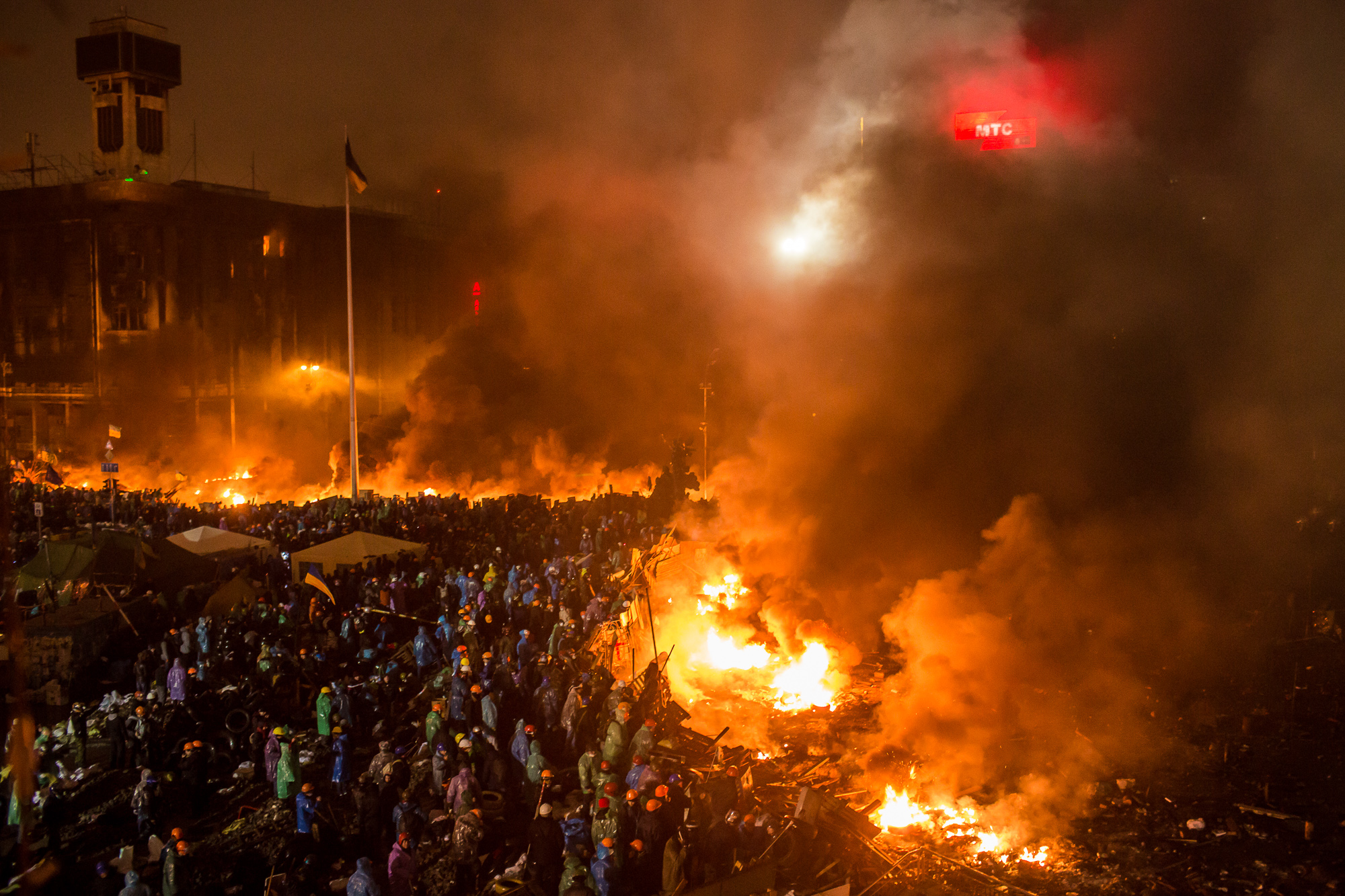
Anti-government protesters stand behind a line of burning tires and debris on Independence Square on February 19, 2014 in Kiev, Ukraine. After several weeks of calm, violence has again flared between anti-government protesters and police as the Ukrainian parliament is meant to take up the question of whether to revert to the country's 2004 constitution.
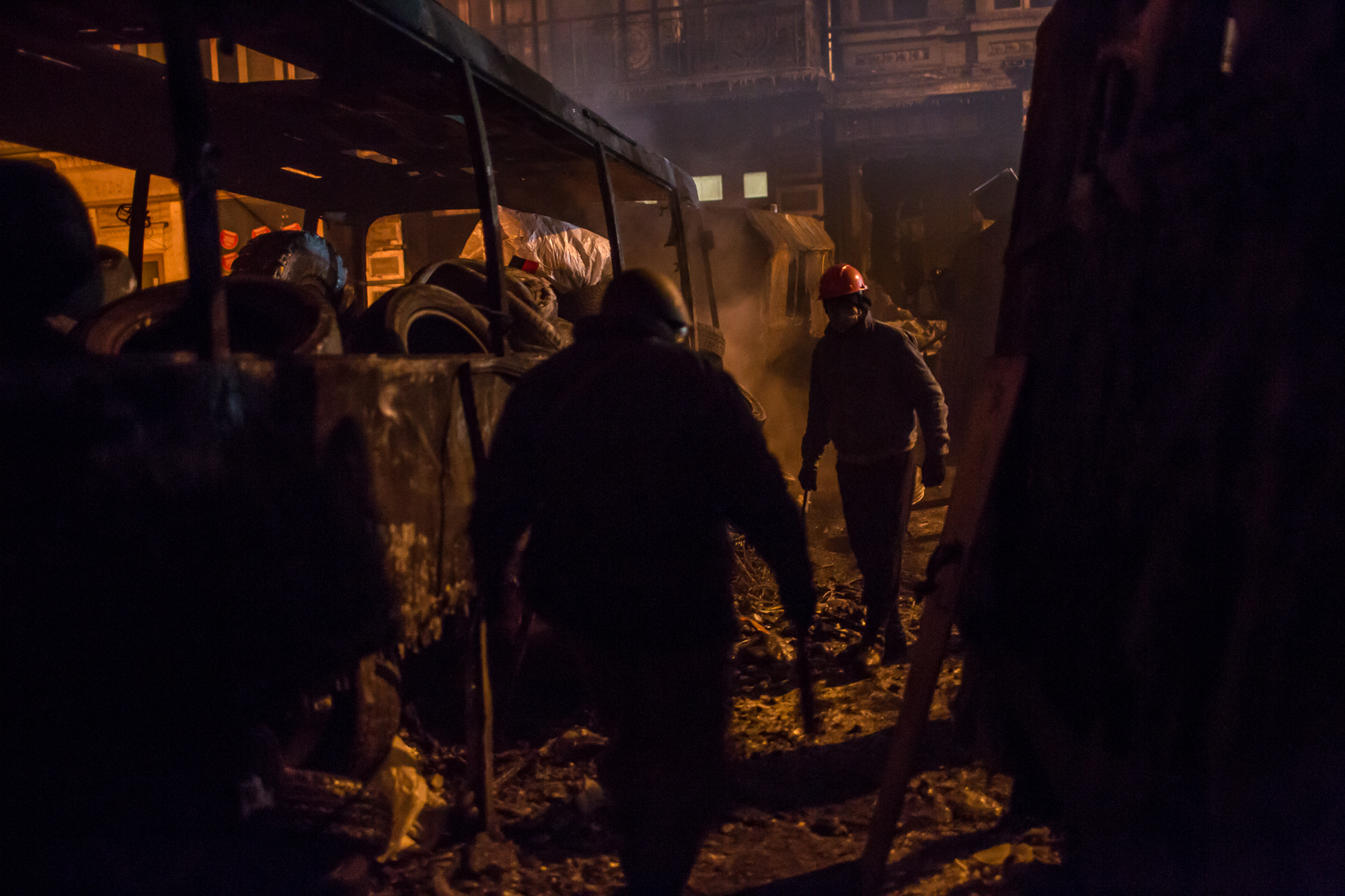
Anti-government protesters walk among burned buses on Hrushevskoho Street near Dynamo stadium on January 25, 2014 in Kiev, Ukraine. After two months of primarily peaceful anti-government protests in the city center, new laws meant to end the protest movement have sparked violent clashes in recent days.
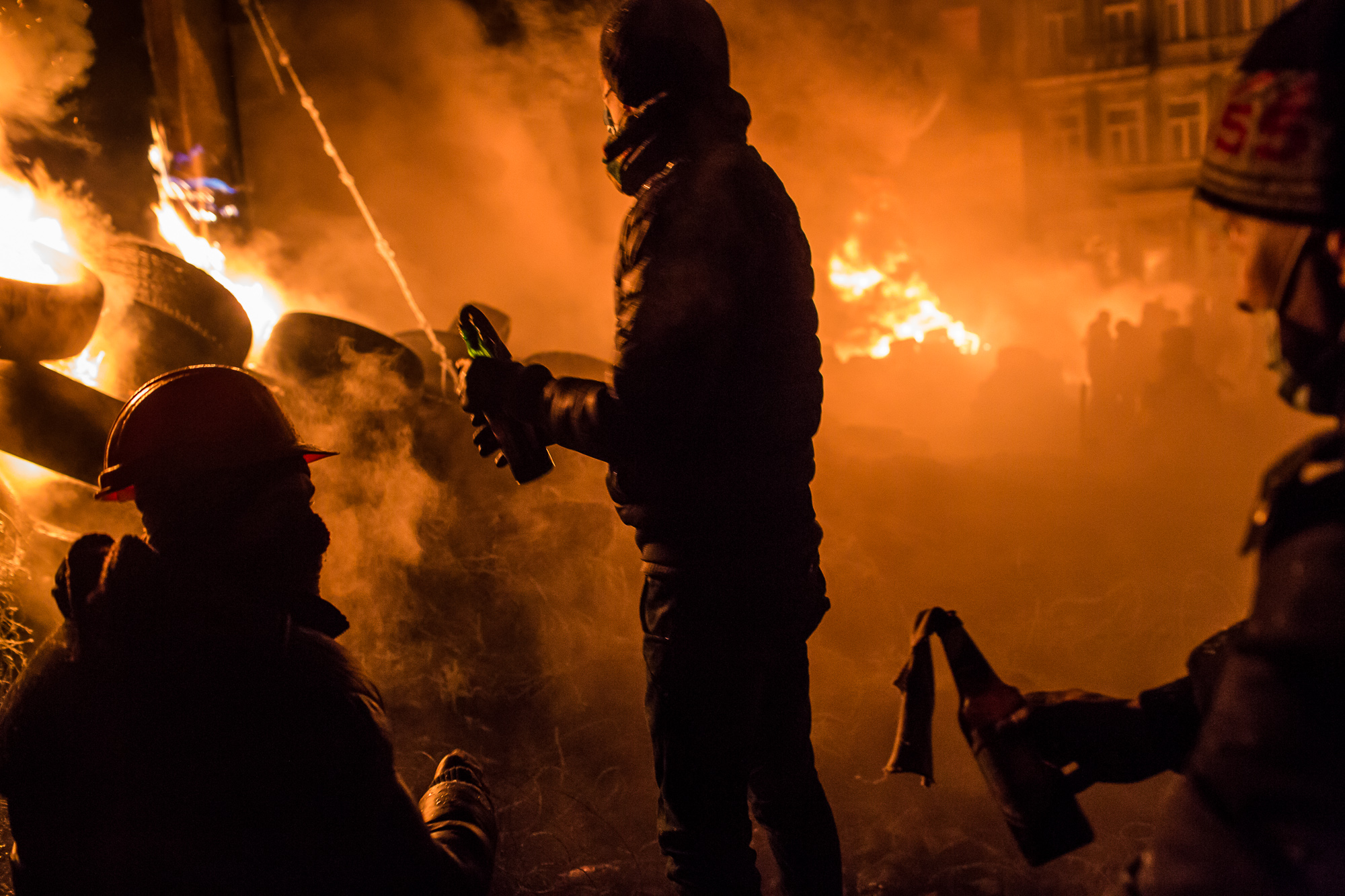
Anti-government protesters prepare to throw Molotov cocktails during clashes with police on Hrushevskoho Street near Dynamo stadium on January 25, 2014 in Kiev, Ukraine. After two months of primarily peaceful anti-government protests in the city center, new laws meant to end the protest movement have sparked violent clashes in recent days.
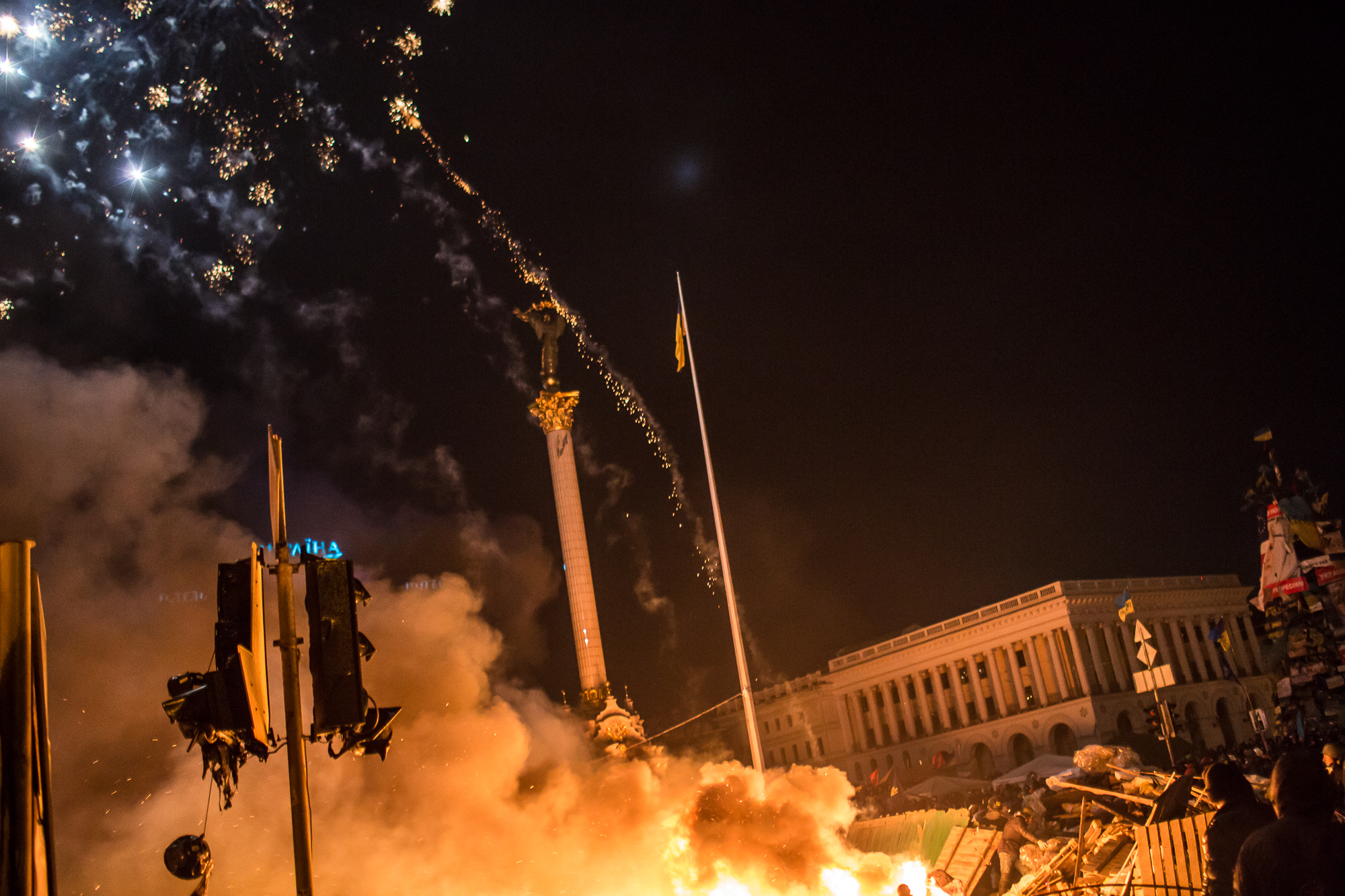
Fireworks fly over Independence Square, known as Maidan, during clashes in the early hours of on February 19, 2014 in Kiev, Ukraine. After several weeks of calm, violence has again flared between police and anti-government protesters, who are calling for the ouster of President Viktor Yanukovych over corruption and an abandoned trade agreement with the European Union.
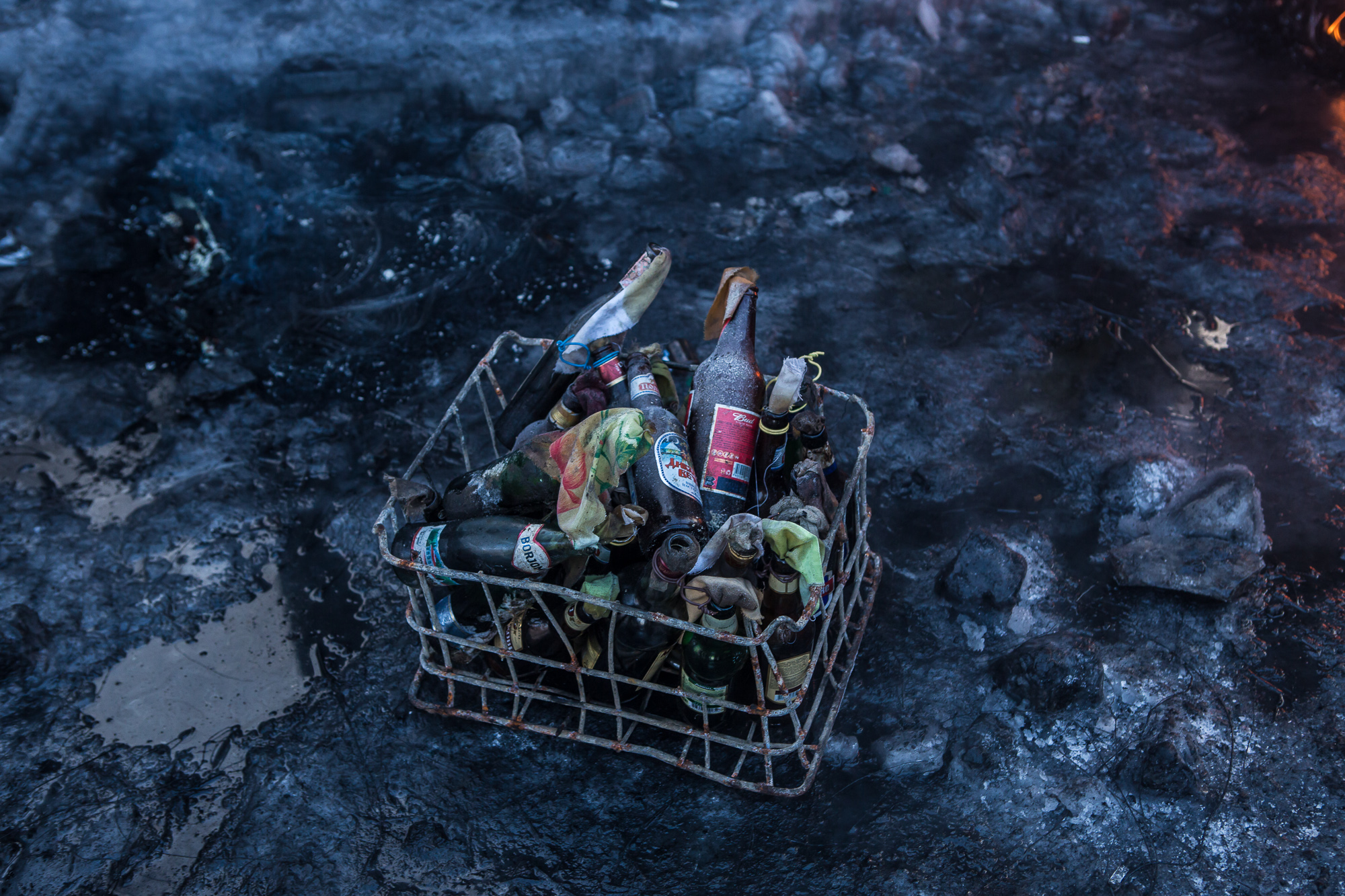
Incendiary projectiles are ready to be used by anti-government protesters near Dynamo Stadium on January 24, 2014 in Kiev, Ukraine. After two months of primarily peaceful anti-government protests in the city center, new laws meant to end the protest movement have sparked violent clashes in recent days.
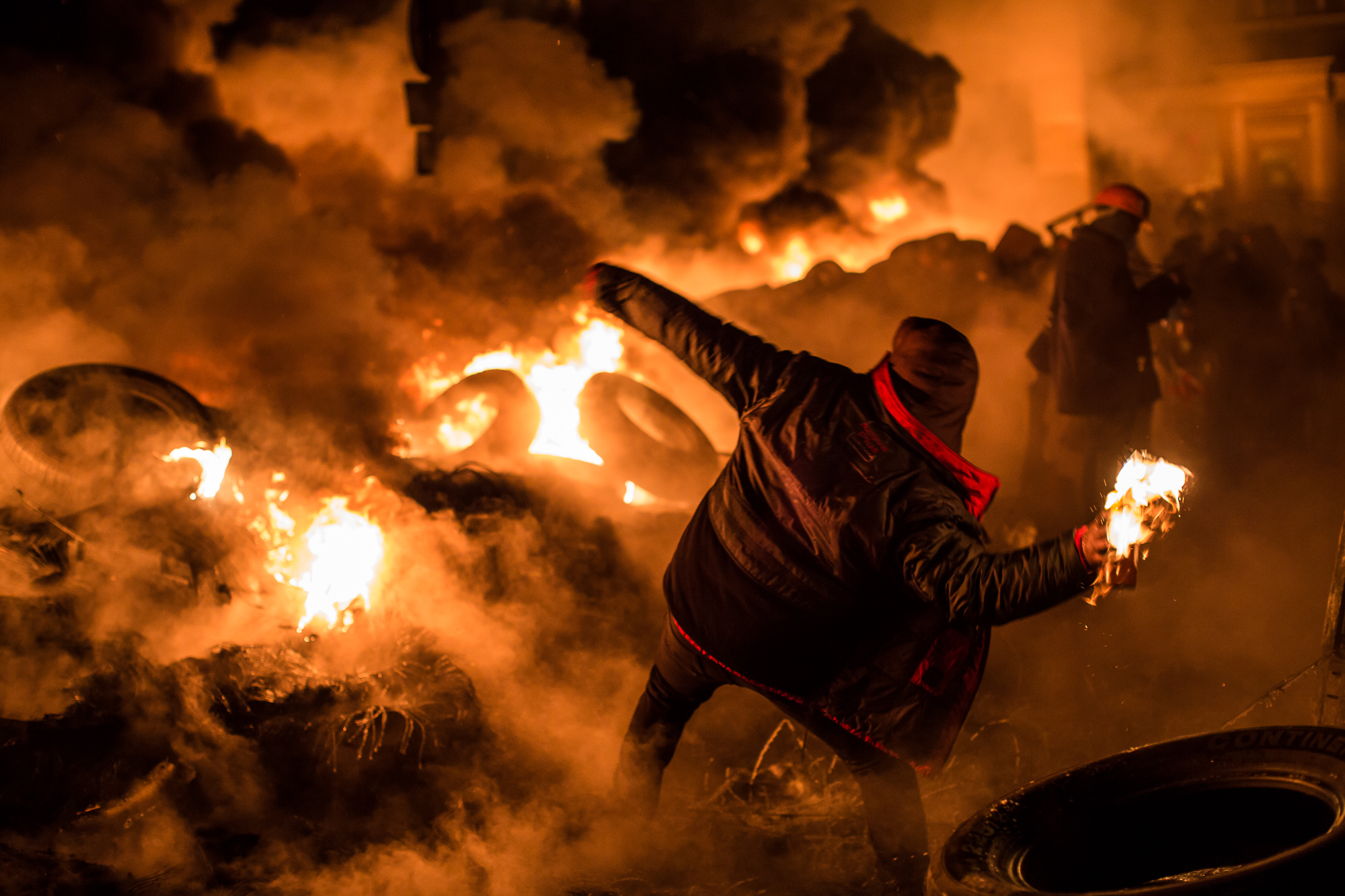
An anti-government protester throws a Molotov cocktail during clashes with police on Hrushevskoho Street near Dynamo stadium on January 25, 2014 in Kiev, Ukraine. After two months of primarily peaceful anti-government protests in the city center, new laws meant to end the protest movement have sparked violent clashes in recent days.
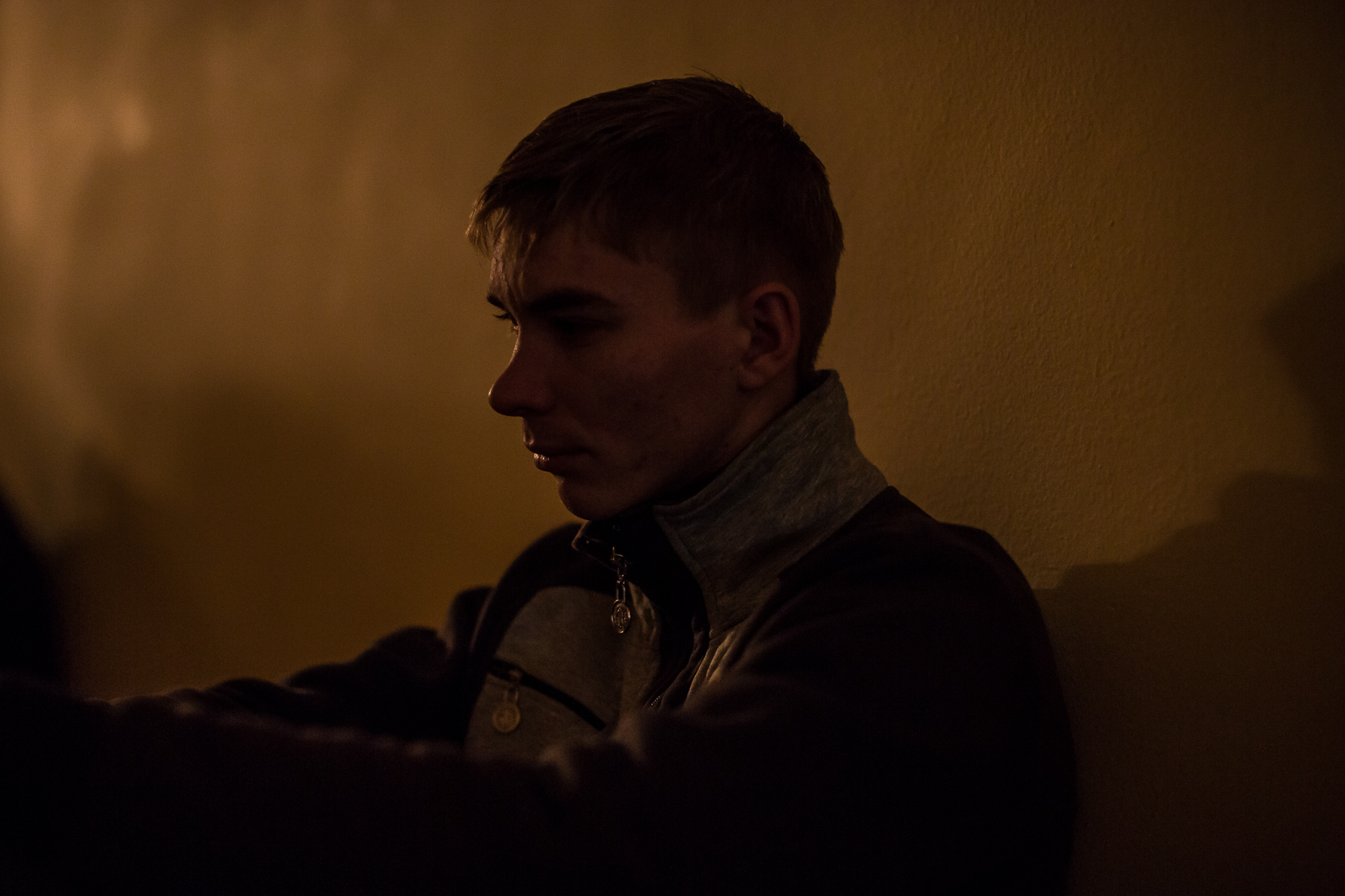
Taras Chumak, 20, from the town of Ivano-Frankivsk, rests inside the International Center of Culture and Arts, which is occupied by anti-government protesters, on December 8, 2013 in Kiev, Ukraine. Thousands of people have been protesting against the government since a decision by Ukrainian president Viktor Yanukovych to suspend a trade and partnership agreement with the European Union in favor of incentives from Russia.

Berkut riot police shoot rubber bullets toward anti-government protesters on Independence Square on February 19, 2014 in Kiev, Ukraine. After several weeks of calm, violence has again flared between anti-government protesters and police as the Ukrainian parliament is meant to take up the question of whether to revert to the country's 2004 constitution.

A priest blesses a gravely wounded anti-government protester after medics stopped trying to save him in the lobby of the Hotel Ukraine, which has been converted to a medical clinic and makeshift morgue, on February 20, 2014 in Kiev, Ukraine. After several weeks of calm, violence has again flared between anti-government protesters and police, with dozens killed.
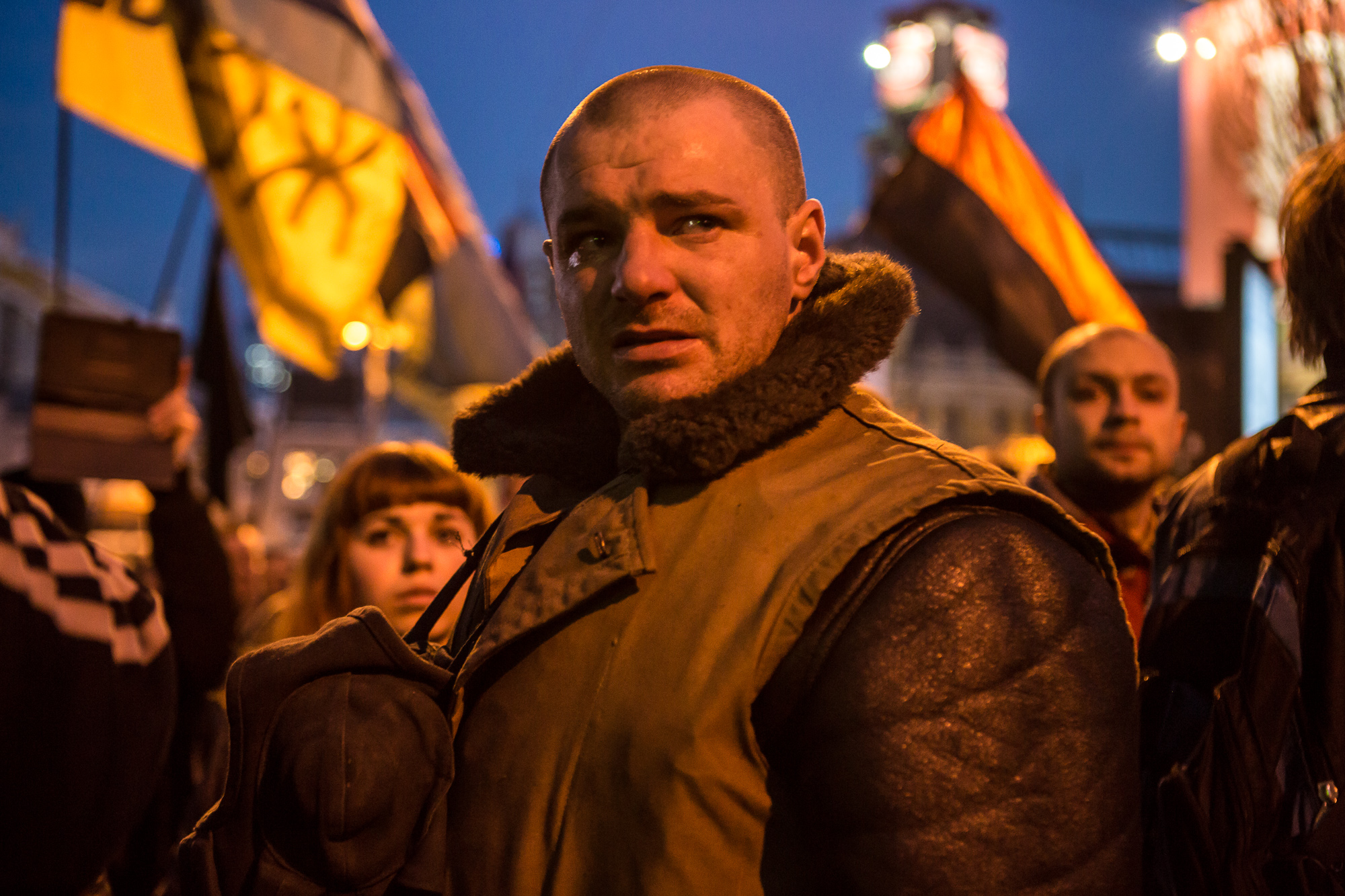
A man cries after seeing the body of Ustim Holodnyuk, 19, who was killed in fighting between anti-government protesters and police, carried in procession through Independence Square on February 21, 2014 in Kiev, Ukraine. After a week that saw new levels of violence, with dozens killed, opposition and government representatives reached an agreement intended to resolve the crisis. (Photo by Brendan Hoffman/Getty Images)
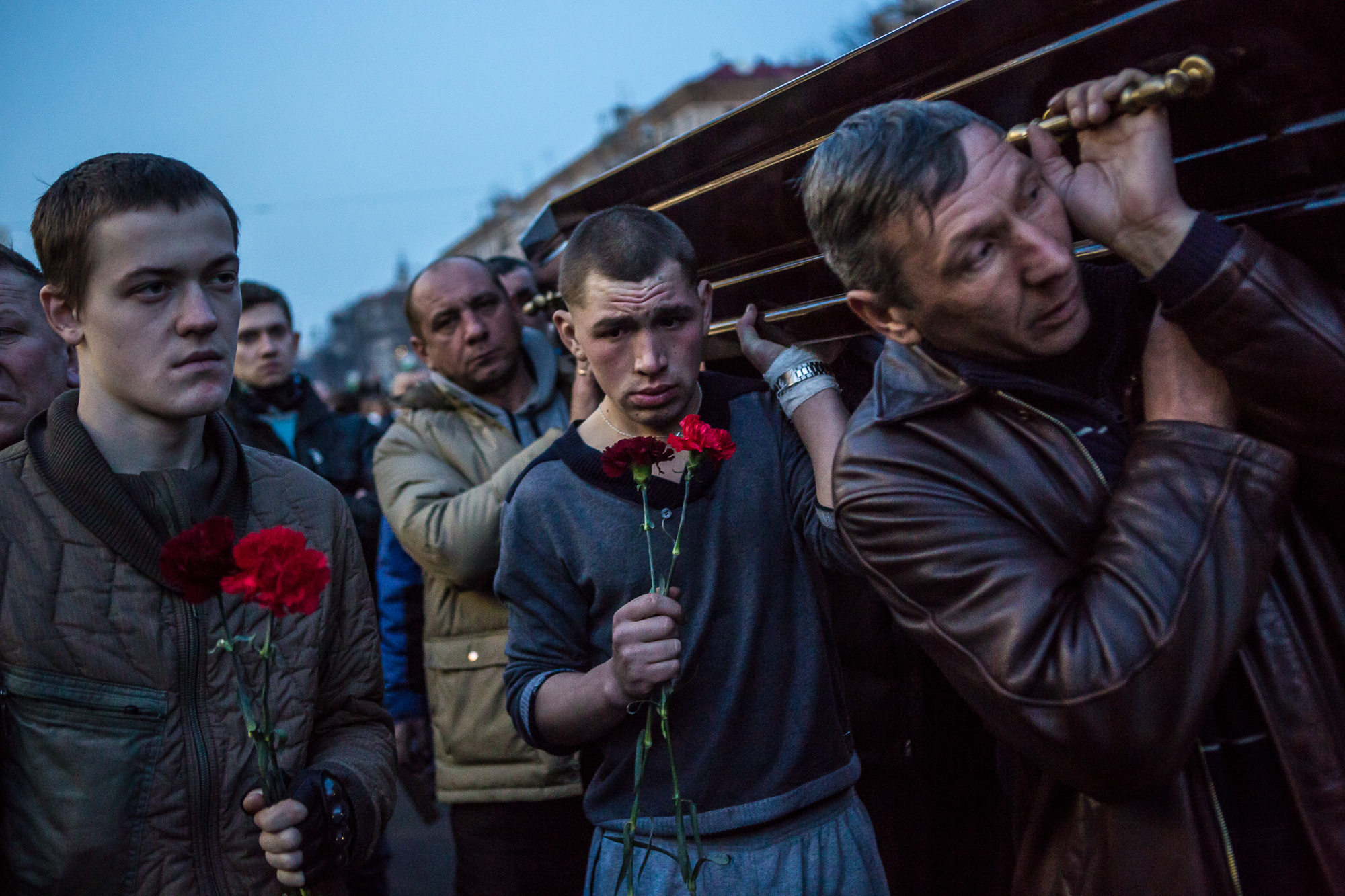
Men carry a casket containing the body of an anti-government protester killed in clashes with police from Independence Square on February 21, 2014 in Kiev, Ukraine. After a week that saw new levels of violence, with dozens killed, opposition and government representatives reached an agreement intended to resolve the crisis.
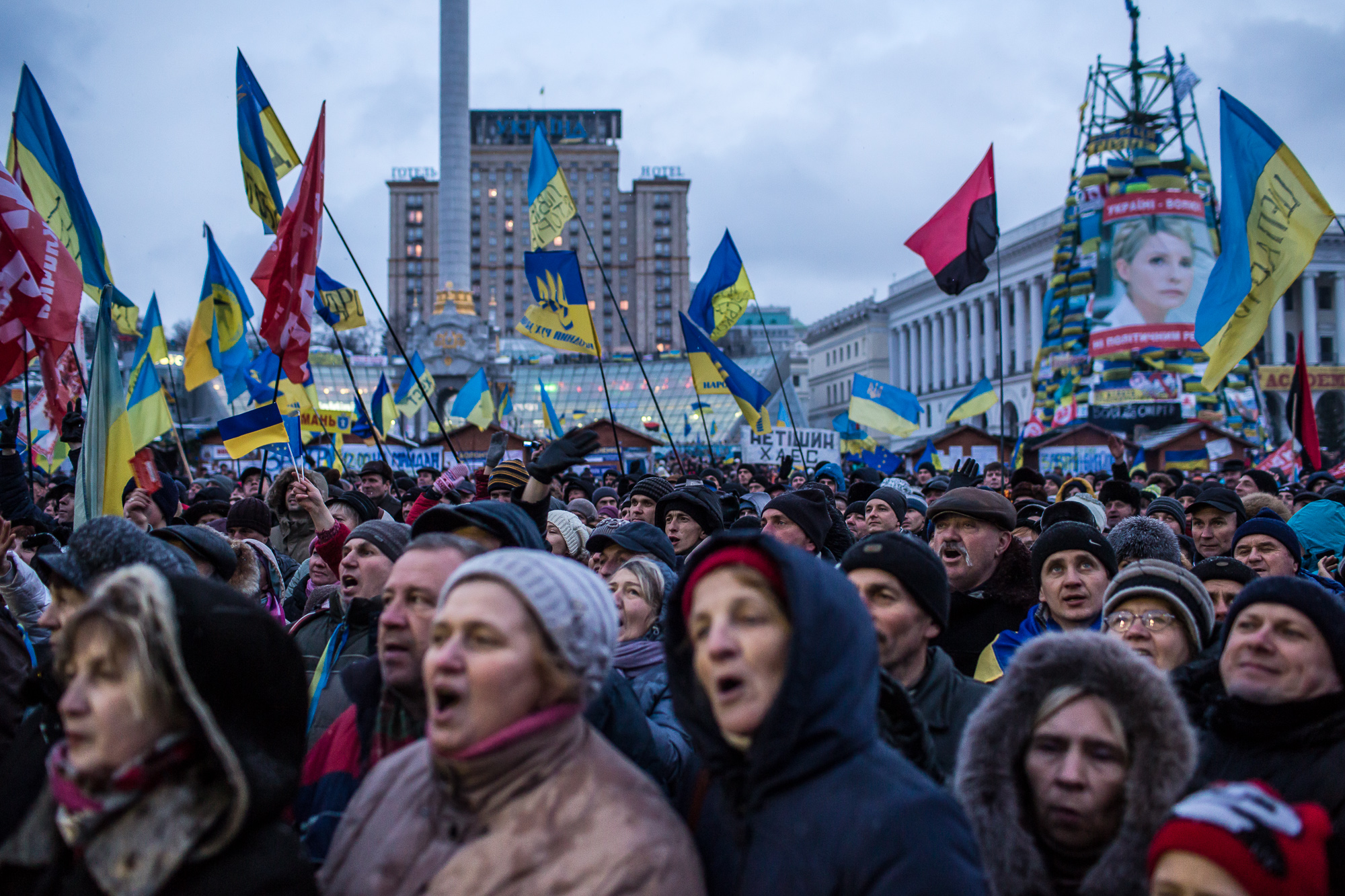
Anti-government protesters rally on Independence Square on December 7, 2013 in Kiev, Ukraine. Thousands of people have been protesting against the government since a decision by Ukrainian president Viktor Yanukovych to suspend a trade and partnership agreement with the European Union in favor of incentives from Russia. (Photo by Brendan Hoffman/Getty Images)

A person wrapped in a Ukrainian flag watches the sun set over Independence Square on December 4, 2013 in Kiev, Ukraine. Thousands of people have been protesting against the government since a decision by Ukrainian president Viktor Yanukovych to suspend a trade and partnership agreement with the European Union in favor of incentives from Russia.
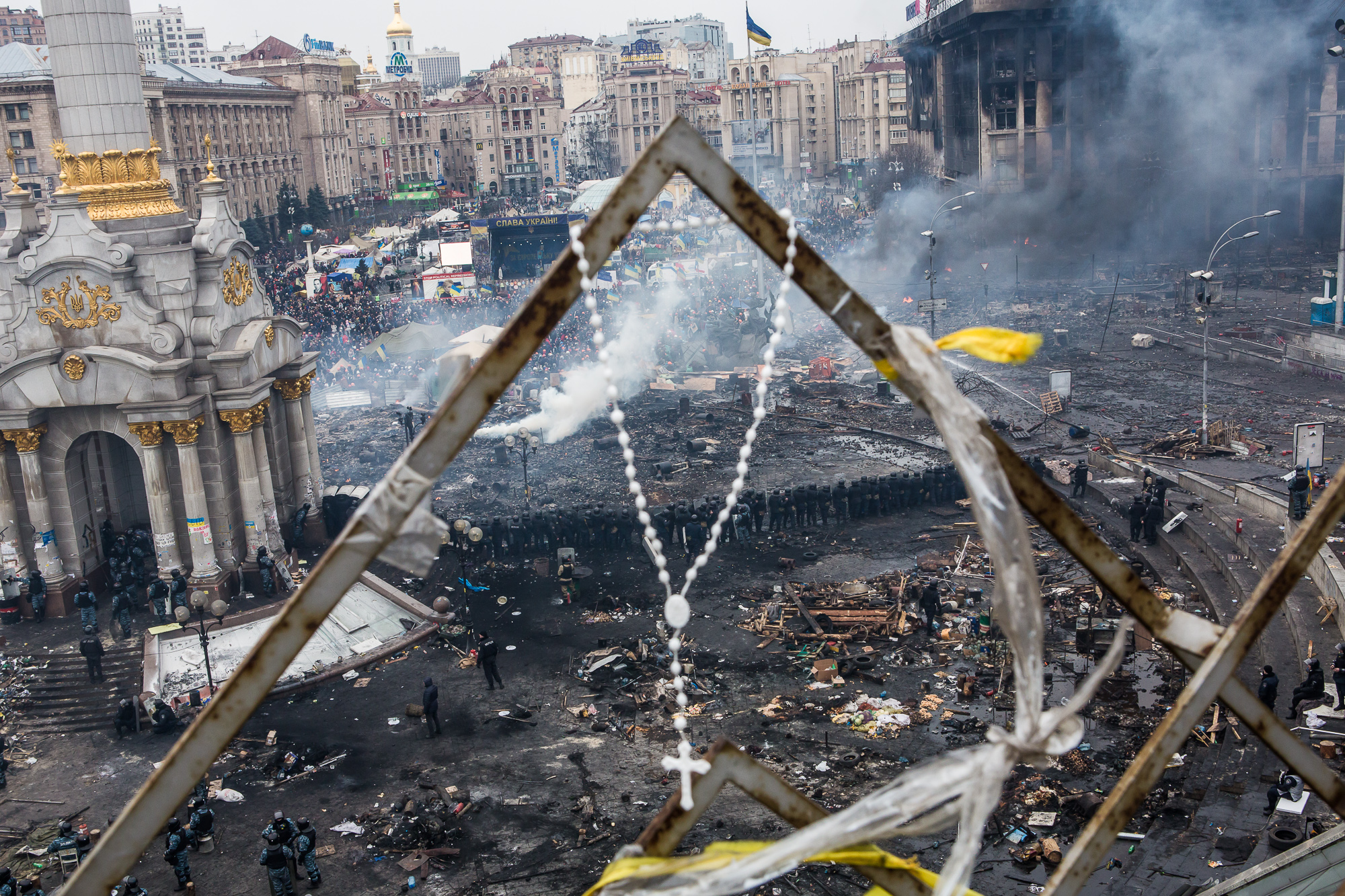
Police form a barrier in Independence Square on February 19, 2014 in Kiev, Ukraine. After several weeks of calm, violence has again flared between anti-government protesters and police as the Ukrainian parliament is meant to take up the question of whether to revert to the country's 2004 constitution.
December 2013 - February 2014
When President Viktor Yanukovych of Ukraine announced on November 21, 2013 that he would not sign a trade and partnership agreement with the European Union, thousands of people in Kyiv took to the streets in protest. They were angry that Yanukovych was instead pursuing closer relations with Russia, despite longstanding promises that he would sign the EU agreement. To young people in Ukraine, the EU represented a stable, democratic future and respect for the rule of law, while stronger ties with Russia would only reinforce a culture of official corruption.
Several attempts to quash the protests only deepened the resolve of anti-government demonstrators, and for months the occupation of Independence Square—"Maidan" in Ukrainian—remained largely peaceful. But in mid-January 2014, a raft of legislation meant to end the protests was fast-tracked through Parliament, sparking violent confrontations between radical protesters and police. Several protesters were killed by gunfire, and they fought back from behind barricades of burning tires with Molotov cocktails, fireworks, and rocks launched by massive slingshots. With the crisis reaching new depths in late February, President Yanukovych lashed out and over 80 people were killed when government snipers opened fire on protesters. Two days later, Yanukovych was forced out of office amid evaporating political support.
While the crisis in Ukraine quickly pivoted to the Russian occupation of Crimea and a Russian-backed war in eastern Ukraine, the primary goal of the Euromaidan protests was achieved with the removal of Viktor Yanukovych as president. As the new government of Ukraine struggles to move forward and maintain unity, Yanukovych is on the run, wanted for mass murder.
